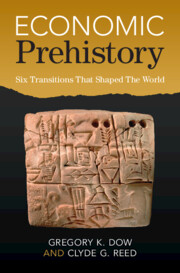Book contents
- Economic Prehistory
- Economic Prehistory
- Copyright page
- Dedication
- Contents
- Figures
- Tables
- Preface
- Acknowledgments
- Abbreviations
- Part I Prologue
- 1 Economics Meets Archaeology
- 2 A Primer on Malthusian Economics
- Part II Sedentism and Agriculture
- Part III Inequality and Warfare
- Part IV Cities and States
- Part V Epilogue
- References
- Author Index (Abridged)
- Subject Index
2 - A Primer on Malthusian Economics
from Part I - Prologue
Published online by Cambridge University Press: 10 February 2023
- Economic Prehistory
- Economic Prehistory
- Copyright page
- Dedication
- Contents
- Figures
- Tables
- Preface
- Acknowledgments
- Abbreviations
- Part I Prologue
- 1 Economics Meets Archaeology
- 2 A Primer on Malthusian Economics
- Part II Sedentism and Agriculture
- Part III Inequality and Warfare
- Part IV Cities and States
- Part V Epilogue
- References
- Author Index (Abridged)
- Subject Index
Summary
Population dynamics are central to any theory of economic prehistory. This chapter explains the Malthusian framework widely used by economists. We rely on these ideas throughout the book. The exposition is graphical and should be accessible to non-economists. We define a production function and the average and marginal products of labor. With fixed natural resources and a fixed technology, food per person decreases as the population of a geographic area increases. Decreasing food per person tends to lower fertility and raise mortality. These demographic effects yield an equilibrium with a stable long-run population. If technology improves, food per person rises at a given population level. In the short run this raises the standard of living for the existing population, but in the long run, population growth brings the standard of living back down to its previous level. The main implication is that in the long run, technological innovation or a better climate raises population but not living standards. We discuss the relationship of these ideas to the concepts of migration, carrying capacity, population density, and population pressure. We conclude with a review of empirical evidence supporting the relevance of Malthusian models for pre-industrial societies.
Keywords
- Type
- Chapter
- Information
- Economic PrehistorySix Transitions That Shaped The World, pp. 50 - 64Publisher: Cambridge University PressPrint publication year: 2023



